- Animals, Bees, Chickens, Cob, Compost, Composting toilet, Gardening adventures, Health, Heirloom Plants, Herbs, Natives, Permaculture and Edible Forest Gardening Adventures, Ponds, Rain Catching, Recipes, Salads, Soil, Vegan, Vegetables, Vegetarian, Worms
Southern California Permaculture Convergence! Be there!

Southern California Permaculture Convergence If you are interested in any aspect of permaculture, such as organic gardening, herbs, planting native plants, aquaponics, natural ponds, beekeeping, keeping chickens, and so much more, then you must come to the Southern California Permaculture Convergence. It happens on March 9th and 10th at the Sky Mountain Institute in Escondido. The keynote speaker will be Paul Wheaton, lecturer and permaculturalist extraordinaire of www.permies.com fame. Oh, and I’ll be one of the many speakers as well (cough cough). The Early Bird special of only $50 for both days ends at the end of January, and then the price will rise, so buy your tickets now!
Also, for a full-on demonstration of taking bare land and creating a permaculture garden, there will be a three-day intensive class taught by Paul Wheaton on site the three days prior to the Convergence.
You can read about the convergence here at the official website, which will give you the link perm.eventbrite.com where you may purchase tickets. Also visit the SD Permaculture Meetup page to see all the free workshops that happen monthly all over San Diego.
This convergence is such a deal, you really shouldn’t miss it! And such a bargain, too. One of the best things I find that come out of these convergences is the exchange of ideas and networking among the attendees, and all the practical information you can take home and use right away. One of the largest parts of permaculture is building community, which means sharing with and assisting others.
Really. Don’t miss this! Tell your friends!
-
Keep In Your Pets: It is Predator Season
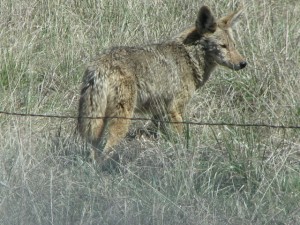
This juvenile coyote was playing with his litter mate at the Santa Rosa Preserve in plain site of the road. Youth just aren’t cautious, no matter what species. Photo by Miranda Kennedy We are entering the time of year when outdoor cats, small dogs, free-range chickens and any small pet go missing. Pre-adult (aka teenage) coyotes from this year’s early litters are just as hungry and just as fearless as human teens, and they are looking to fill growling stomachs during the day and night. (Besides, a study by University of Nebraska found that feral cats are responsible for the extinction of 33 species of birds worldwide. Keep your cats contained!) Can’t blame coyotes because this is their land. Preditors are an important part of our ecosystems and the removal of them have devastating effects on our ecosystems, all the way down to the plants in a process called trophic cascade. During this heat wave I’ve been sleeping with windows open. At about 5:15 am I heard the hens going crazy down in their Fowl Fortress . Throwing on my white robe and slippers I ran down the hill towards the coop. Just before I reached it, a young handsome coyote came around the corner behind the compost bins and we nearly collided. He was across the property and over the chain link fence in a heartbeat. The hens were safe because the Fortress is wired up both sides and across the top, and the wire goes into the dirt. However if the coyote were to have time to dig he could have been inside. The hens were so upset that they didn’t lay right for several days. Miss Amelia, the leader, was on top of the chicken tractor screeching away. Chickpea and even formidably-built Lark were on top of the smaller coop. These three survived the coyote attack that killed two of their friends last winter (pre-Fowl Fortress). The two adopted Rhode Island Reds were standing by the door wondering what all the fuss was about; they’ve seen our two elderly, partially deaf and blind dogs walk past all the time. General Mischief, whose probably only working park is his sniffer, lumbered excitedly around the property following the coyote’s path. At night I began to lock the hens inside the chicken tractor where they roost inside the Fortress, so that they’d have two lines of defense.
The next morning I arose to chicken screeching even earlier, and ran down there to see a coyote coming from around the back of the Fortress. I knew where it would jump the fence so I ran in that direction, which gave it quite a surprise as it had to pass me to get there. I stood at the fenceline brandishing a rake that I had caught up on the way down the hill, dressed in slippers and long white robe, shouting threats into the neighbor’s backyard like a lunitic. One thing about growing older is that eccentric behavior is excused.
I wasn’t about to let the coyotes believe they could hunt within my fence. The next morning I was up and out just after five, me and General, my rake and my white robe, over which I’d pulled a red jacket because the morning was misty. I stood at the fenceline, pulling some ragweed to not waste time. In about five minutes I felt that they were coming and stood waiting. Sure enough, halfway across the neighbor’s property were some bushes and from around behind them trotted a coyote. He looked pretty jaunty and sure of himself until he turned and caught an eyeful of me. I shook my rake and he seemed to shake his head disbelievingly. Then he cut out the way he had come. Victory for me!
I collected dog poo and dumped it along the fenceline, and stuck clumps of fur left from shaving General’s thick coat into the top holes in the fence. I love the country life.
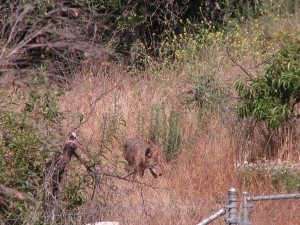
Of course I didn’t bring a camera on my morning patrols. This coyote was in what is now the Bee Garden, several years ago. He looks worse for wear. Photo by Miranda Kennedy. For the next few mornings I’d roll out of bed, motivate Sophie and General to get up and go outside, and I’d patrol the fence and make my presence known at the entry point. Although I was sleep-deprived (with the late darkness I tend to only get dinner at about 9 and to bed by 11) I managed to to get some impressive gardening done, especially since I changed into old clothes before heading out. There was no more coyote activity, at least none that the hens told me about.
The other night the pack was running down in the streambed and were yipping and howling in communication. I think it was just past midnight, but I went out there just to make sure there were no visitors.
Sophie is a 14 year old rescued pit bull mix I’ve had since she was about a year old. I knew that she had run with coyotes as a youngster when her owner let her loose, and I never understood why she hadn’t been attacked. Her back legs don’t work well, and she’s feeling her age. She used to climb the chain link fence and roam the neighborhood. She used to kill cats, chase rabbits, keep the mice and rats out of the garage where they used to sleep. For the last few years it has been all peace and love with Sophie. She not only seems to be afraid of some of the cats in the house, but would walk past the ranging hens without putting any of her thoughts into action. I once went to wake her up when she was still sleeping outside, and a mouse ran out from under her. I’d disturbed its warm cozy sleep.
So this morning I let out the dogs when General woke me up and tried to go back to bed. It never works because when General is done he rakes the metal security door with his nails until I let him in again. Sure enough, in about five minutes he was demanding attention again so I put on my robe and went out to do the hens. I was just past the driveway when I caught sight of Sophie on one of the garden paths close to the house. She had a friend with her. A coyote. Sophie was just turning away from it to walk back to the house and the coyote was looking around at the bushes, hopeful for a rabbit breakfast until it saw me and scooted away. The fur was raised a little on Sophie’s back, but not all the way. I made sure he was clear of the property, and checked the hens who were still double locked in. Then I had a few words with Sophie about the choice of friends she asked over!
-
Fowl Fortress
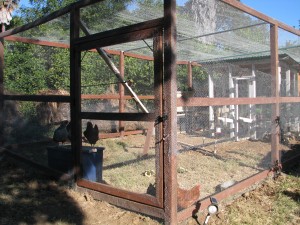
Front of Fowl Fortress I wanted to protect my hens from rats, snakes, weasels, raccoons, hawks and possible nuclear destruction, so I had the Fowl Fortress built. I was going to try to do it myself (ever taunting the gods of construction with my ineptness in this field). I bought Redicrete, t-posts and aviary wire. Then I came to my senses. I’m having shoulder and back problems, I wanted the coop to be done by the time I left to pick up my daughter from Oregon last week, and I really didn’t want the coop to be an eyesore.
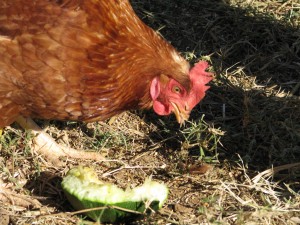
Partially blind Madge enjoying zucchini And I only wanted the best for my girls!
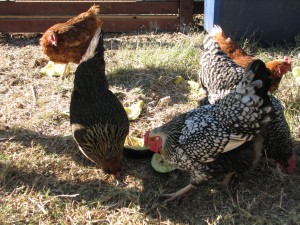
L-R: Viola, Chickpea, Miss Amelia, Lark and Madge So I hired the contractor who put up my wooden fence a few years ago. He said he’d do it over the weekend. Of course, not only didn’t it get done until 7 pm the night before I left the state, but he’d run over a whole lot of plants with his trailer, broke an irrigation line and a small tree, was scooping buckets of pond water to use for the cement because he didn’t see the HOSE and HOSE BIB that was right there (I found two buckets left over the weekend, and they had live mosquito fish and a pond snail in them! Ummm… habitat area! No-kill zone! Gee!). Frustration mounted and didn’t make my tension headaches go away despite chiropractic adjustments. And the coop was far more expensive than I had imagined. Survey question: how many of you who have had a construction project, have been given a no-show excuse of “a broken water heater in San Diego (substitute a city that is close but not too close) ? For me, it has been two contractors who have used that excuse. I’m catching on.

The side view. A solar light is in the ground for nighttime protection. Still, I ended up with a nice-looking, sturdy coop. It has a wire roof, and the wire goes down a little ways into the soil, but on one side the rats can still scoot under, so I need to secure it with rocks and more dirt. The girls love the coop because they can range around during the day safely, and they have plenty of good dirt bath places as well. I had a 4-foot door installed so that I could get large things in and out. Aviary wire is small-gauge wire, smaller than poultry wire. It should keep most vermin out. It is doubled at the bottom which will help keep small snakes from getting in or getting caught in it. I can also subdivide the coop on the inside if I wanted to put other birds in there (frizzles? ducks?) and keep them from being pecked by the ladies.

The coop doors are open all the time now. The two coops are inside and the girls mix it up when it comes to egg laying. I want to get the quail run inside, too, but it will take a little more lifting power than just my daughter and me. I’ve moved it myself, out of the truck and down the property, by leverage, ramps, and tilting it over onto my garden cart so that it is balanced on part of the roof. I tried that again the day before I left, but the ground was sloped and I lost control of the whole thing. I managed to get it back down for the quail and only did minor damage to myself. Wonder Woman I am no longer!
-
They Followed Me Home, I Swear

Viola and Madge How many times do you go to the store for a couple of items and come back with a bag full? Too often for me. Yet, I persist in shopping. I went to the feed store for chicken scratch, and came back with new friends.

Madge's bad eye. She can find her food pretty well, though! These are two Rhode Island Red hens, about a year old, who had been victimized to the point of injury by sister hens. Too many birds in a small holding pen will do that, plus the whole pecking order thing. Most of us are familiar with that from living through middle school.

Viola's limp isn't this bad; she's just being dramatic for the camera. The larger bird is blind in the right eye. Her name is Madge (she looks like a Madge!). The smaller girl has a limpy leg, and her name is Viola (Twelfth Night). (Have you ever really looked at the word twelfth? I spelled it phonetically as twelph, and knew it was wrong but then had a hard time figuring the real spelling out after seeing it. Sorry… digression). Both are missing a lot of feathers in various places. These two were in a cage by themselves, and get along famously. The poor dears each laid an egg in the cardboard box in which they were transported.

A surprise in the box. Poor girls! I’ve put them in Emerson’s old run (oh, and his price has gone down to $15 and the warning sign is off his pen) until I can build the Hen House of my Dreams.

Temporary shelter in Emerson's cage. My other three girls, Lark, Chickpea and Miss Amelia are a happy trio and I don’t want to upset the apple cart, nor have the newbies subjected to pecking order again.

Lark (getting a bit fat) with Chickpea and Miss Ameila. I bought this fantastic chicken house some months ago, thinking it would be a warm spot for my three hens (wasn’t that a TV show? It should be one!) but they rejected it wholeheartedly. My girls are used to more space. I figured this pen would be good for some smaller breed. I’ve been looking for frizzle hens, but no one seems to have them. If I order from a hatchery it is straight run, which means unsexed chicks, and I don’t want to do the rooster thing again.

The Quail House. I’d like to establish California quail on the property, but since they are the state bird it is illegal to farm them here. Hatcheries in other states will send eggs, but at this moment I don’t have the time to care for eggs (and I’m too heavy to sit on them, although I do get broody a lot). I contacted Project Wildlife for rehabilitated quail for release, but they release within three miles of where the animals were found, which is an excellent policy. I’ve posted on Craigslist for both frizzle hens and Ca. quail, but no responses yet.
The quail that is commonly sold is the coturnix. These are Japanese quail. Because of their looks they are also called Egyptian quail, Pharaoh quail, and other names. They are less nervous than Bobwhite or button quail, they don’t fly up a lot so they don’t bang their heads on the top of the cage. They lay delightful brown speckled eggs. The feed store had a new shipment in, and they weren’t just selling pairs, so I bought three beautiful little girls, about six months old.

Saki. Very contempletive. My daughter did a quick and imaginative search for names and came up with a lot of really good ones. With a nod to the breed’s origin and alternative names, the dark brown one is called Saki, short for sakura which is Japanese cherry, rice wine, or also short for the Sakkara, which is an Egyptian city of temples. Covers all bases there. The mostly white one is called Benu, which is an Egyptian bird god you can read about here: http://www.thewhitegoddess.co.uk/articles/ancient_egypt/the_benu_bird.asp . The light brown one, incongruously, is named after Agatha Christie’s character Miss Felicity Lemon, most notably played by Pauline Moran in the Poirot television series. It was too good a name not to use, although rather long for such a handful of a bird.

Benu in the back, and Miss Felicity Lemon in the front. The quail don’t have much personality as yet. Of course, they had been raised crammed in cages with many other birds, shipped through the mail service, then moved to another cage with many other birds. They had arrived at the store on Sunday. These three are settling in slowly, enjoying the personal space and the tall weeds that have grown inside the coop (it is bottomless). After all the strange sounds and smells become commonplace, they’re personalities will emerge. They don’t scare or fly when approached, but hunker down in a fatalistic “this is my last moment on earth” kind of way. Already they are showing more hope in small ways as they react to my voice. I put them upstairs in the coop last night, but they were down again this morning. Their cage has handles so it can be moved when they’ve thoroughly manured that area. (There, I’ve said the ‘m’ word again!).

The RIR's eggs are on the left. Americauna and Silver Wyondotte on right. So more beaks to feed. At least I’m staying away from the Fallbrook Animal Sanctuary, at least for awhile. General Mischief and Sophie are too old for a new dog, and I certainly don’t need any more cats.
Of course, the llamas at the feeds store, and those really cute guinea pigs, could really use a home….
-
Mrs. Two Shacks Builds a Fowl Go-Kart and a Hen Harem

And its a... go-kart? Okay, so… my chickens are currently in a deluxe San Diego summer unmovable chicken tractor. The tractor is too heavy for me to move, and the wheels (reused) have literally crumbled apart. Now it is November and the nights are becoming chilly, and we’re on the weekend rain schedule, unlike our other dry years. (Normally it rains the weekend after Thanksgiving when all the holiday events are happening, which gives the weeds time to grow so that everyone is mowing just before New Years.) My hens are cold. I know, it isn’t Minnesota; the nights are in the 40’s, but that is nippy to Southern California-bred chickens. I’ve been pondering what to do for some time now, and my Libra self has vacillated so much that now I’m up against it. Yesterday I devoted to trying to build a warm place for the chickens. I ended up with a go-kart.

I have a cage and a crate: I'll put them on wheels! I am not one to cut wood. I go out of my way to find matching pieces of wood in my huge and glorious scrap pile just so that I don’t have to measure and cut wood, because invariably I will cut it the wrong length. Fabric, too, (I have some interesting curtains). Determined to make a warm, cozy hen structure that was safe from predators (a coyote jumped the fence and killed Kakapo and took Linnet on Saturday. I was and am heartbroken and angry. I have three hens left. Oh, and Emerson.) I found a huge wooden crate that was used for a sculpture of a rodeo rider, which belonged to my parents. This thing has been taking up space for maybe twenty years in various locations. It looked the perfect size for three hens. I dragged it down the hill to the newly-straw-covered area in front of my new two sheds.

Hammering together four pieces of wood on wheels takes skill Fifteen years ago, at another house, in another life, I built a movable chicken coop that was gosh-darn good. I didn’t cut any wood for that one, either. Anyway, I still had the casters left. Pulling two long and two short pieces of 2×4 (notice I don’t give a length) out of the wood pile, I hammered them together and attached the casters, although not in that order, which made the hammering together more difficult. I purposefully didn’t use screws: I wanted to bang away with something hard on something yielding. I attached the crate after scraping out the spider webs. Now I wanted a caged area for the hens to be able to graze and get some sun. I still wasn’t completely sure where I was headed with all of this, but I was driving anyway. I dragged down an old large animal cage, which used to support a heat lamp for my African Spur Thigh tortoise until he outgrew it and tore the door off. I could fit it onto the front part of the… thing… and the casters would go through the holes in the bottom with a little help from a PVC hacksaw. (Cutting PVC is NOT the same as cutting wood, by the way, and I have oodles of experience with it. Red Hot Blue Glue nearly runs in my veins.)

The wheels fit through the wire! Wheee! I found some brackety-gizmos that made an L shape, and attached them to the bottom so that the cage hung down closer to the ground so that the hens could get at the grass.

L-shaped thingies, and the hammer head that kept flying off I attached two pieces of wood in a ‘T’ as a handle (trying to hammer it onto the frame through the cage), and then found an old dog choke collar with some lead still attached, and wrapped that around to help pull.

The pull handle, complete with choke chain. So, what if it rained? It needed a roof. There happened to be three of these triangular things left from the shed removal. I’m glad they were put to use. They had been a failed attempt to put up cat fencing (to keep them in the yard) on top of the shed roof by a friend who was a contractor. (He’s also the reason why the 8-foot wooden fence I asked for turned into a 5-foot fence up on bricks with a teal slanted cap running along the top… which makes a nice foothold for the cats.)

I knew there would be a use for these, if I waited long enough! I nailed these suckers on the crate, (ever try to nail something triangular?),

Ever try to hammer something triangular? (The successful nail is on the outside end!) then pulled out a piece of corrugated aluminum that wasn’t too sharp (and was also conveniently on top of the pile). It was too long, and not wide enough, so I grabbed some big scissor things I’ve had in the shed for years and cut the aluminum in half (they were tin snips!). Roughly. On purpose. Of course, the piece I cut didn’t fit, so I had to bend it in half, stepping on it, and drape it over the triangles then nail it on. The larger of the two I used towards the front, to give a little shade. The sun was going down and I had to hurry.
Then stuffing straw in the gap for insulation, adding a milk crate and straw inside for eggs, I stepped back to enjoy my creation.

Ummm, doesn't quite fit. Well, it wasn’t quite a chicken tractor, and it wasn’t quite a warm and cozy house. It was a go-kart.

Hay insulation I had thought to move it and the hens up into the relative safety of the tortoise and cat yard, since the cats were not allowed into the yard right now because two naughty individuals escape (so everyone else has to suffer, just like in school). With much pulling and pushing, I managed to get the kart around to the front of the hen house, and there it stayed overnight. I couldn’t get it any farther. The casters would work fine if the mulch wasn’t so thick, and if I didn’t have to pull it uphill. There was no way I was going to be able to get the kart uphill through the mulch into the tortoise yard.
Today I managed to move the kart over some grass, and one by one brought the hens over and popped them in. I got some very curious looks back from them. The chickens thought it was pretty fun, and enjoyed pulling at the tops of the grass sticking up through the cage, but after awhile they set up a chorus that couldn’t be ignored. And I still hadn’t solved the problem of their being cold at night! It was again about to be dark.

Hens wondering how to make it go Grabbing a rather stinky dog blanket, an old flowery sheet and a pillowcase (they were there, all right?) and the staple gun, I went to work. I stapled the blanket all across the back of their regular hen house loft, across the roof and let it dangle down in front of where they roost at night. Sticking my head in there (and holding my breath…. very doggie-smelling) I noticed a slight breeze still, so I stapled up the sheet and pillowcase. Emerson was quite baffled as to what I was doing next door.

How to make an expensive, well built chicken tractor look like junk in ten minutes. Then I brought the hens back, and figured it would have to do until after the holiday. A day and a half’s work and I have a heavy fowl go-kart and taudry drapings around the hen house, but I think the hens are warmer tonight. And, I must say, I think the kart is pretty cool-looking.

Gipsy hens Happy Thanksgiving!
-
Dedicated to Evelyn

Almost time.... We’ve gathered seven eggs from the girls this week. We believe the first one was Evelyn’s, the beautiful blond Buff Orpington. The next ones are Miss Amelia’s, followed by a blue/green one from Chickpea and unbelievably, a brownish one from our other Americauna, Kakapo.

First three beautiful eggs, L-R Evelyn's, Miss Amelia's and Chickpea's The two Barred Rocks are too young yet to lay, but they certainly are interested in what is suddenly so popular about the nesting boxes.

The Barred Rocks are curious teenagers The nesting platform in the chicken tractor isn’t deep enough to keep straw from being kicked off, so I’ve put up three bee ‘supers’, which are four sides and no top or bottom. Until something else can be arranged, they do just fine.

Miss Amelia, tail up and ready to get it over Watching the girls as they become hens has been interesting. Miss Amelia sat in the nesting box and panted.

As a mom, I know how she's feeling. She allows me to pet her now, as she squats into the mating pose. It is a little disturbing, and doubtlessly frustrating for both her and Emerson who is caged separately.

Miss Amelia is desperate for... attention. Sorry! Chickpea, the big girl, jumps from box to box annoying everyone trying to nest in there. She kicks as much bedding out as she can, sending it flying across the coop with her big feet. When she’s ready to lay she goes into a chicken trance. You can wave your hand in front of her eyes and there is no response, just some panting. Then, voila! A beautiful greenish egg.

Chickpea in a trance Kakapo is the nest builder. She’ll squat down in one of the boxes then lean her head far out of it, almost losing her balance, to grab a wisp of straw to throw over her shoulder into the box.
We hadn’t seen Evelyn lay, but assumed the first egg which was pointier than Miss Amelia’s, was hers. She’d been in a mood for several days and had settled down. Yesterday, though, she sat down in the corner of the pen by her beau Emerson and took a nap in the daytime which was uncharacteristic. She appeared perfectly healthy; in fact, I commented on how red and full her wattles were. This morning we found our dear Evelyn dead on the floor in the corner of the coop. We also found two eggs with transparent shells in the lay box. There was no evidence of what made her die, but I’m guessing it had something to do with the egg-laying. We don’t know who laid the shell-less eggs, but that shouldn’t kill anyone. It is remedied with more calcium in their diets on top of their lay pellets. Perhaps she was egg-bound, or just couldn’t handle the eggs. We were horrified and greatly saddened. I buried Evelyn under the lime tree just behind the coop. Now we have five hens and a rooster. We gave the girls crushed egg shells and kale leaves, and I’ll sprinkle calcium on their food tomorrow. We’ll miss the beautiful Evelyn something terrible.

Evelyn looking great. No signs of illness. -
Segregating the Rooster, or Building a Bachelor’s Quarters out of PVC

Bachelor Pad If you’ve read my earlier chicken posts, you’ll know that we bought seven hen chicks, and one of them turned into a rooster. Since we are vegetarians and animal activists (and just plain softies), I opted to try and keep him. I don’t want fertile eggs or chicks. So far the neighbors haven’t complained about the crowing and I kind of like it. The store from whence he came said that they’d give a refund, but Emerson (the rooster) would end up as an employee’s dinner or in the dumpster. Squawk! I contacted my very amenable and patient vet Dr. Pyne about ‘fixing’ him, which I found out is what capons are (which was common practice up until fairly recently, and capons were often used to sit on eggs because they were calmer than the hens. Hmmm.), but since the rooster’s, um, or-gans, are internal, this would be an involved surgery and we left it at that (he’s fixed feral cats for me, helped my tortoise, many dogs… I wish he could be my personal doctor because I’d get better treatment there!).
Since E-Day (Egg Day) is coming up in August, when the six hens will be old enough to start laying, and since Emerson has become more aggressive with them, and since the chicken tractor is too small for that many chickens anyway, I decided to add on. I am terrible at measuring things. I do just as good a job eyeballing a length or walking a thing off and counting my foot lengths as I do with yardsticks or measuring tape. I have an interesting set of curtains as proof of this. No matter how I try, and how clear-headed I am with the numbers, I get it wrong. If I am to build a thing, I have to start with pre-measured lengths and not cut them. About fifteen years ago I built a very respectable movable chicken coop that way, using 2x4x8’s, a lot of chicken wire, screws and piano casters. I didn’t cut any wood. However that had to be dismantled when we moved and I used the wood for other projects.

Facinated Audience If something bends or stretches, now, hoo-boy that’s a whole ‘nother story! I’m all over it! So today my ever-patient and forgiving daughter and I stood out in the blazing sun for a good eight hours and glued together a chicken coop extension made of leftover 3/4 inch PVC water pipe! My sketch, of course, was on the back of some unopened junk mail, but I only had to run to the hardware store once in the middle of the day for some extra fittings. Much as I don’t want to contribute any more to the manufacturing of plastic, I had all this pipe leftover so I’m recycling. The coop is a rectangle divided in half lengthwise with chicken wire, so half of it becomes a bachelor quarters for Emerson, and the other half an extended run for the hens. They will access it through a hole cut into the wire on the side of their coop, and they can keep company with Emerson on two sides of the coop without being, um, disturbed. Emerson isn’t going to be very happy about it, but we certainly didn’t ask him to be a rooster, either! In fact, he was the smallest and least-aggressive looking chick in the bunch.

The door was made of 1/2 inch PVC PVC is fun to glue; it bends and is forgiving, and if it is a little off, on a project like this, it’s okay! If anyone ever asked me what kind of fingernail polish I use, I’d have to say Red Hot Blue Glue. Working with wire is another story. I believe that all discontented former employees, people with grudges who believe that the world is either out to get them or owes them more than what they have, all work at poultry wire companies. Rolls of wire are treacherous and evil. When you uncoil the thin wire that binds each roll of tightly wound chicken wire (or any other, for that matter), the roll slips and tries to nip off your fingers. The outer edge is raggedly folded under, and the cut ends poke out at angles so as to scratch you and draw blood no matter how careful you are. As you reach the end of the roll it requires almost superhuman strength to unroll, and if you are working alone it will recoil with a snap that can take you up with it. Any work with poultry wire, no matter how innocent, ends in several copiously bleeding scratches and possible loss of limb.

Framed! By seven o’clock tonight, we’d finished his side enough to move him in. My daughter went to catch him and boy did he put up a fuss, making all the girls panic. You’d think we’d tortured him every day since his second day on earth instead of treating him as a pet. Perhaps I should put a photo of a dumpster or a stewpot up in his quarters just to make him reconsider his behavior.

Wire around all sides So tonight Emerson is separated. The girls were very concerned and he looked confused, but they share a wall at night and can plainly see each other. He has a roost near theirs, too. We didn’t get the girl’s side attached yet, and we need more chicken wire for their roof (we wired a tarp over it temporarily). I’ve also decided that I will put wire on the bottom as well. The PVC is lightweight and I’m afraid of raccoons getting under it. I could always put it on small wheels and make a chicken tractor out of it, or fill the entire thing with water to make it heavier! Or not.
I point out to my daughter constantly that other people are at the beach, or doing some typical summer activity, while we glue a coop, cob an oven, trim nails on our cat… all of which draw blood, come to think of it. The chickens are laughing.
-
Chickens in the Tractor

Grass? Easter Sunday brought new horizons to the chickens. Finally they were allowed out into the tractor. The largest bird, one of the Americaunas, was almost touching her head to the screen over the top of the Sterilite container in which they lived. The girls were a little startled at the sunlight, and didn’t quite understand about grass at first. Then they got into scratching with their already huge feet and pecking off weed tips.

First Scratches Unfortunately, the Barred Rocks girls are still smaller than the others and were being pecked and chased by the larger girls. They chose their corner and the big girls grouped on the other side of the tractor. They all wandered and changed positions with some pecking going on. The BRs were just too frightened, so I set the bird cage in which they had been living into the chicken tractor and put them into it. They have their own food and water, perches, and are able to be with the big girls without being set upon. Funny thing, though, the BRs would hop up onto the two cross-boards when escaping the big girls, but I’ve never seen one of the big ones up on the boards. I think this is because the BRs lived in the bird cage and learned to perch!

Barred Rock Corner I was wary about allowing the dogs out into the yard with the chickens in the tractors. In their younger days, these two killed all of our chickens who were loose in our backyard. It was a Valentine’s Day massacre. That was the day DC met her end (see post about DC the chicken). Now that the dogs are senior citizens and mostly deaf, they didn’t take as much interest as before.

General Interest in Chickens When they came too close to the cage, I used a spray bottle of water and admonishments. It seems to have done the trick. That spray bottle is what keeps the cats under control in the house, too. I just have to pick it up and all bad activity stops. I wish it worked on kids as well!
At night, the chickens still don’t know how to get up onto their loft. After dark my son and I go out there and drape a blanket around the BR’s birdcage for warmth, and find the big girls in a group on the ground. Chickens at night are like footballs, and can be picked up easily and placed into their loft. We’ve tried to get them to walk up the ramp, but it is too much of a learning curve for them. We’ve also set them up on their loft during the day, but they just flutter down. I have to believe that they’ll grow into it.
It is nice to have the chickens out of the side room, and really good for them to be scratching and pecking and enlarging their diet with grass and bugs. They certainly eat a lot of chicken food. Pretty soon it will be lay mash time!

Pretty Girls -
When Chickens Fly
My seven chickens are quite the young women now. They really should be out in a pen, not still in a Rubbermaid container in the side room, but tractor work will be started this week and I don’t want to horrify them with large machinery. The big girls have begun to squat on the floor like broody hens. Most of their feathers are in and they look very sleek and lovely. The Americaunas, who are almost two week older than the others, are much larger and also much shyer. They are usually at the bottom of the pile when I go in to change their water. Why is it that I’ve held them, fed, watered and cleaned them, crooned to them, and every time I put my hand in there they start screaming and flying around as if I’m going to murder them? I’ve explained my vegetarianism to them, after all!

Lovely Ladies Then there are the two smaller girls, the Barred Rocks. These girls have attitude. They were in a large cardboard box for awhile, but the larger of the two kept jumping up and out. Last week I found that they were in the same container as the larger girls! Apparently they both got out of their own box, had a time pooing on the floor, then went exploring into the big girl’s domain. The Barred Rocks (BRs) were in one corner, and all five of the big girls were dogpiled in the far corner. They were all frightened of each other! (Yes, the term chicken comes to mind here.) I left them for the night thinking that maybe they’d settle in together (no pecking), but heard intermittant squawks. Apparently the Silver Wyandotte would be brave enough to verture over and scare the BRs, then the larger of the BRs would venture over and scare the others. Geez. So I pulled out an old birdcage and put the BRs in it. They like it just fine, and are enjoying the wooden perches. Of course, teaching chickens to perch in trees is not a good idea, but I have experience with this phenomena.

Barred Rock Songbirds About fifteen years ago, me and my young children were living in a house in Vista along a busy steep road. Across that road was a fenced property with avocado trees and a couple of loud Rottweilers. On the corner of my yard was a tall pine tree that stretched past the convergence of telephone wires.
I had the opportunity to aquire some mature hens from my boss who couldn’t keep them any longer. One in particular was a Barred Rock with an attitude. We were novices at chickens, just claiming cats, dogs, fish and tortoises at the moment. The first night the chickens spent in the garage. Chickens after dark are like moaning footballs. Like bees, they don’t fly after the sun falls, and those who would scream and behave as if they were about to be axe-murdered upon your approach in the light, would in the evening suffer you to pick them up and tote them around like inanimate objects. Inanimate except for the low crooning moans of great distress and sadness that chickens use as lullabys.
I built a very large, and in my opinion, handsome cage for them on wheels (a chicken tractor and I didn’t even know it!), and there they lived. We allowed them to roam during the day when we were home. Then we found that one of the Barred Rocks, and I’ll give her name to you now as DC although that sobriquet was bestowed later, enjoyed flying up to the lowest limbs of the great pine tree. I’d never heard of chickens flying. There are, thankfully, no chicken migrations darkening the sky across the Southwest. If you haven’t seen a chicken for awhile, take a gander at one (oops, wrong fowl) and notice how round and large they are. They are not sleek, flying birds. The BRs, mostly black with white dabblings all over them, look especially rotund and solid, like cast iron. My children and I thought that DC aiming for the heights was, at first, funny.
Then came the day that I went outside to find that DC had set and acquired goals for herself, and had fluttered branch by branch up the pine tree until she was very high up indeed. We tried to lure her down with food and endearments. My son attempted to climb up after her. DC, the most ornery of birds, instead of retreating into the waiting arms of my son, decided to fly. Her first flight was a brief one, more of a fluttering really, to the telephone wires that lined the busy street. There she sat, proudly swaying back and forth on the slender line. If you haven’t seen a chicken on a telephone wire, you really can’t imagine what it looks like. It isn’t like seeing a hawk or another large bird, because they are shaped the way they should be. A chicken, as I’ve said, is like a dark super-sized soccer ball balanced on a wire as if ready to drop any moment. They shouldn’t be that high. I think only seeing an ostrich on a telephone wire would look as strange. The vehicles that came speeding down that hill slowed and made careful detour around the area where she might land if indeed she did drop and shatter their windshields. DC appeared to be about to break her neck, and at this point I was saddened at the thought that it would be her own machinations and not my two hands that would do the act.
My thought now was to get her to fly, or rather drop, back into the fenced area of my property. I don’t remember what time of day it was, but I was dressed in my Park Ranger uniform and badge. There I was, on the far side of the two-laned road in uniform, dodging and directing and apologizing to drivers, an armful of pine cones at the ready, chucking them as high as I could at DC. I am a poor pitcher and none of them came close. However the shouting, the chucking, the passing vehicles and the breeze all made DC come to the decision that she was, indeed, a flying chicken. With grace she launched herself. Chickens don’t fly, but they will, if the wind is willing, glide. She passed unsteadily over the road, causing the driver of a pickup truck to swerve as he caught sight of the immense black object bearing down on his windshield. She just hit managed the top rail of the neighbor’s chainlink fence before teetering over and falling into their yard of avocados.
Dropping my armful of pinecones, saying unpleasant things under my breath, I went to knock at the door of the house who now had a new kind of bird in their yard. No one was home. I’d never met these people, and had only come away with a feeling of slight hostility from them. I went around to the gate in their chainlink fence and the lock was on it but unlatched. Closing the gate behind me I ducked under and around the variety of fruit trees, calling for my lost pet, hoping that the inhabitants of the house were not just lunching on the back porch with their rifles handy. I caught sight of DC, who looked no worse for wear but a little flustered by her adventures and in no mood to suddenly become docile and walk over to me. At the same time that I caught sight of her, I stepped in a pile of poo. A very large pile of poo. That’s when I remembered the Rottweilers.
I froze, listening. I hadn’t heard any barking, not even when I knocked at the front door. That could mean that the huge unfriendly dogs were on the back porch with their huge, unfriendly owners, and all of them had rifles. And as DC headed around the back corner of the house, I thought I’d pause and see what happened before I lost my direct pathway to the side gate.
After no explosions of ammunition or feathers occurred, I went after her. Bent over to avoid branches, hissing so as not to draw attention to myself, chasing her around in circles because chickens are the most uncooperative of animals, I finally cornered her. I threw a stick so that it landed behind her, and scared her enough to run towards me. I grabbed. She screamed and fussed as I ran with her tucked under my arm, not unlike a football, back across the street to the safety of my own yard.
It was afterat we began to clip her wing feathers,, and it was then that she earned the name of DC, which stands for…. Damned Chicken.
-
Chicken Tractors
To most people a chicken tractor sounds like some lame joke. Until fairly recently, I did too. However there are whole websites devoted to them. And as of this week, thanks to local carpenter Jay Tull, I am the proud owner of one!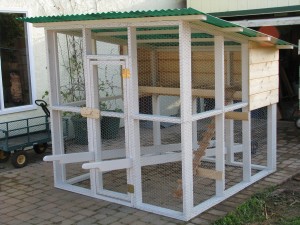
Chicken Tractor One of the fundamental ideas of permaculture is a holistic approach to land management and food supply. Keeping animals that produce food in a compassionate, healthy and useful manner is part of the puzzle. I am a lacto-ovo vegetarian and want dairy products that are produced using humane methods. Therefore, a chicken tractor! A chicken tractor is a movable coop with an unlined bottom. The chickens root around eating bugs, digging up weeds and pooing within the safety of their lovely tractor. You throw in some straw and they mix it into the soil and poo on that, too. In a few days or a week, that square of soil has been dug up, mulched and fertilized and it’s time to move on! So you move your tractor, chickens and all, to wherever you would like them to work next. Meanwhile you collect enriched eggs that have been laid by unstressed chickens who supplement their mash with bugs and greens out in the fresh air.
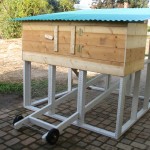
Back view If you have ever eaten eggs from backyard chickens, it may take a little getting used to. That is because the flavor is so interesting and fresh. Going back to supermarket eggs is like switching from chocolate to carob: as a satisfying substitute it just doesn’t fit the bill.
Chicken tractors come in all shapes and sizes. Check out these images: http://home.centurytel.net/thecitychicken/tractors.html. I must admit that my chicken tractor turned out heavier than I’d like, but it’s beautifully made and I’m very happy with it. We’ve joked about entering it in the Christmas parade. If you’re interested in chicken tractors (or chicken arks as they are also called), read Chicken Tractor: The Permaculture Guide to Happy Hens and Healthy Soil by Andy W. Lee. The San Diego County Library system has copies. (Did you know that you can order books from any County library online and it will be shipped to your local library? Visit https://dbpcosdcsgt.co.san-diego.ca.us/search).
This tractor is large enough for maybe four or five chickens at most, which would provide more than enough eggs for me. There are hundreds of web pages that focus just on chickens, and a handy chart that lists egg-laying characteristics can be found here http://www.mypetchicken.com/chicken-breeds/breed-list.aspx, as well as other places. Many birds lay brown eggs or bluish eggs; they don’t have any difference in any respect than white eggs other than shell color, so to pay more for brown eggs at the supermarket is criminal.
Oh, and of course, if there is a chicken tractor, there must be chicks:
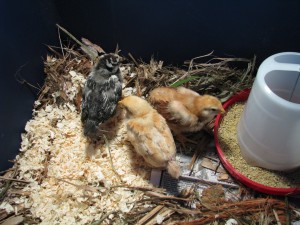
Two week old chicks These three ladies are two weeks old, and are from left to right a Silver Wyandotte, a Buff Orpington, and a Rhode Island Red. I want an Ameraucana (which is a hybrid of Aurucana, which lays the greenish and bluish eggs), and a Barred Rock, which is the traditional black and white chicken, but there were none to be had today as they are very popular. When some become available I’ll raise them seperately until they are mature and introduce them to these three so there is no bullying. Chickens lay eggs without a rooster, and do quite well without being harrassed and pecked at, too. My neighbors wouldn’t forgive a rooster, either. Right now my little chicks are too young for the Tractor, so they live in a Rubbermaid 50-gallon storage container with a 60-watt lamp on one side, water and mash in separate containers, newspapers and shredded bark underneath, and wire across the top because they are Chickens make wonderful pets and have a welcome spot in any permaculture system. Besides, they’re very cute.
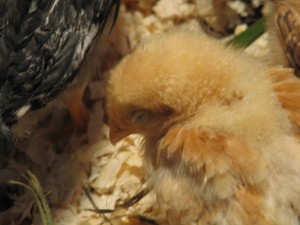
Sleepy chick (Photo credit: Miranda Kennedy)



